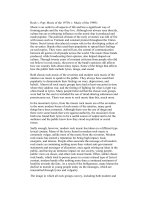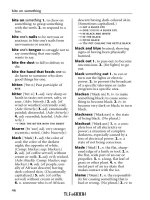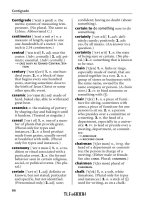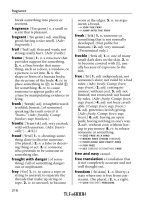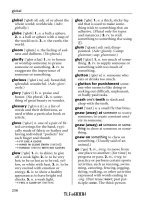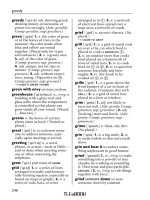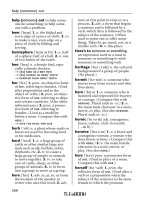Japan''s Built-in Lexicon of English-based Loanwords
Bạn đang xem bản rút gọn của tài liệu. Xem và tải ngay bản đầy đủ của tài liệu tại đây (2.48 MB, 193 trang )
Japan's Built-in Lexicon of English-based Loanwords
SECOND LANGUAGE ACQUISITION
Series Editor: Professor David Singleton, Trinity College, Dublin, Ireland
This series brings together titles dealing with a variety of aspects of language
acquisition and processing in situations where a language or languages other than the
native language is involved. Second language is thus interpreted in its broadest
possible sense. The volumes included in the series all offer in their different ways, on
the one hand, exposition and discussion of empirical findings and, on the other, some
degree of theoretical reflection. In this latter connection, no particular theoretical
stance is privileged in the series; nor is any relevant perspective – sociolinguistic,
psycholinguistic, neurolinguistic, etc. – deemed out of place. The intended readership
of the series includes final-year undergraduates working on second language
acquisition projects, postgraduate students involved in second language acquisition
research, and researchers and teachers in general whose interests include a second
language acquisition component.
Other Books in the Series
Focus on French as a Foreign Language: Multidisciplinary Approaches
Jean-Marc Dewaele (ed.)
Second Language Writing Systems
Vivian Cook and Benedetta Bassetti (eds)
Third Language Learners: Pragmatic Production and Awareness
Maria Pilar Safont Jordà
Artificial Intelligence in Second Language Learning: Raising Error Awareness
Marina Dodigovic
Studies of Fossilization in Second Language Acquisition
ZhaoHong Han and Terence Odlin (eds)
Language Learners in Study Abroad Contexts
Margaret A. DuFon and Eton Churchill (eds)
Early Trilingualism: A Focus on Questions
Julia D. Barnes
Cross-linguistic Influences in the Second Language Lexicon
Janusz Arabski (ed.)
Motivation, Language Attitudes and Globalisation: A Hungarian Perspective
Zoltán Dörnyei, Kata Csizér and Nóra Németh
Age and the Rate of Foreign Language Learning
Carmen Muñoz (ed.)
Investigating Tasks in Formal Language Learning
María del Pilar García Mayo (ed.)
Input for Instructed L2 Learners: The Relevance of Relevance
Anna Nizegorodcew
Cross-linguistic Similarity in Foreign Language Learning
Håkan Ringbom
Second Language Lexical Processes
Zsolt Lengyel and Judit Navracsics (eds)
Third or Additional Language Acquisition
Gessica De Angelis
Understanding Second Language Process
ZhaoHong Han (ed.)
For more details of these or any other of our publications, please contact:
Multilingual Matters, Frankfurt Lodge, Clevedon Hall,
Victoria Road, Clevedon, BS21 7HH, England
SECOND LANGUAGE ACQUISITION 26
Series Editor: David Singleton, Trinity College, Dublin, Ireland
Japan's Built-in Lexicon of
English-based Loanwords
Frank E. Daulton
MULTILINGUAL MATTERS LTD
Clevedon • Buffalo • Toronto
Library of Congress Cataloging in Publication Data
Daulton, Frank E.
Japan's Built-in Lexicon of English-based Loanwords / Frank E. Daulton.
Second Language Acquisition: 26
Includes bibliographical references and index.
1. Japanese language–Foreign words and phrases–English.
2. English language–Study and teaching–Japan. I. Title.
PL664.E5D38 2008
495.6'2421–dc22 2007029788
British Library Cataloguing in Publication Data
A catalogue entry for this book is available from the British Library.
ISBN-13: 978-1-84769-030-2 (hbk)
Multilingual Matters Ltd
UK: Frankfurt Lodge, Clevedon Hall, Victoria Road, Clevedon BS21 7HH.
USA: UTP, 2250 Military Road, Tonawanda, NY 14150, USA.
Canada: UTP, 5201 Dufferin Street, North York, Ontario M3H 5T8, Canada.
Copyright © 2008 Frank E. Daulton.
All rights reserved. No part of this work may be reproduced in any form or by any
means without permission in writing from the publisher.
The policy of Multilingual Matters/Channel View Publications is to use papers that
are natural, renewable and recyclable products, made from wood grown in
sustainable forests. In the manufacturing process of our books, and to further support
our policy, preference is given to printers that have FSC and PEFC Chain of Custody
certification. The FSC and/or PEFC logos will appear on those books where full
certification has been granted to the printer concerned.
Typeset by Datapage International Ltd.
Printed and bound in Great Britain by the Cromwell Press Ltd.
Contents
Acknowledgements . . . . . . . . . . . . . . . . . . . . . . . . . . . . . . . . . . . . . vii
Introduction: The Importance of Cognates for EFL in Japan. . . . . . . . 1
Part 1: Japan’s Importation of English
1 The Assimilation of English into Japan ese
Á
A Historical and Linguistic Overview . . . . . . . . . . . . . . . . . . . . 9
2 Today’s Generation of Gairaigo 24
Part 2: Gairaigo and Language Acquisition
3 Resolving the Paradox of Cognates . . . . . . . . . . . . . . . . . . . . . . 43
4 The Effect of Loanwords in Japanese on the
Learning of English . . . . . . . . . . . . . . . . . . . . . . . . . . . . . . . . . . 61
Part 3: The Built-in Lexicons
5 Common Loanword Cognates for High-frequency and
Academic English . . . . . . . . . . . . . . . . . . . . . . . . . . . . . . . . . . . 77
6 Quantifying the Overlap and Quality of
Japanese/English Cognates . . . . . . . . . . . . . . . . . . . . . . . . . . . . 87
Part 4: Exploiting Japanese Loanword Cognates
7 Barriers to Acc essing Cognates . . . . . . . . . . . . . . . . . . . . . . . . 101
8 Extending Word Knowledge Within Word Families. . . . . . . . . . 110
Epilogue
Á
New Horizons . . . . . . . . . . . . . . . . . . . . . . . . . . . . . . . . 123
Appendix 1. The Standard Set of Katakana 131
Appendix 2. The List of Common Loanwords Corresponding
to the BNC 3000 . . . . . . . . . . . . . . . . . . . . . . . . . . . . . . . . . . . . 133
Appendix 3. Academic Borrowed Words . . . . . . . . . . . . . . . . . . . . . 156
Appendix 4. The Similarity of 1K Sampled Borrowed
Words and Japanese Loanwords . . . . . . . . . . . . . . . . . . . . . . . . 164
Appendix 5. The Similarity of 2K Sampled Borrowed
Words and Japanese Loanwords . . . . . . . . . . . . . . . . . . . . . . . . 168
v
Appendix 6. The Similarity of 3K Sampled Borrowed
Words and Japanese Loanwords . . . . . . . . . . . . . . . . . . . . . . . . 171
References . . . . . . . . . . . . . . . . . . . . . . . . . . . . . . . . . . . . . . . . . . . . 173
Index . . . . . . . . . . . . . . . . . . . . . . . . . . . . . . . . . . . . . . . . . . . . . . . . 183
vi
Japan’s Built-in Lexicon of English-based Loanwords
Acknowledgements
Thanks to Ha
˚
kan Ringbom for providing supportive commen ts through-
out the preparation of this book. Sections have been read and commented
on by John Crosetto, Tyrone Daulton, Susan Krashinsky, Mayumi
Okamoto, Linh Pallos, Paul Stapleton, Jeannet Stephen, Meredith
Stephens and Emi Uchida; I am very grateful for all this help.
Ryukoku University has provided support for this publication.
This book is dedicated to my parents, who loved books.
A note on scripts:
English vocabulary items will appear in the Roman alphabet underlined
(e.g.
word). Japanese loanwords will appear in the Roman alphabet
underlined and italicised (
waado), using a modified Hepburn Romani-
sation; occasionally loanwords wil l appear in their katakana forms
(e.g.
).
vii
Introduction: The Importance of
Cognates for EFL in Japan
Sometimes worlds are linked by words. English night, for example, is
related to
nuit (French), Nacht (German), nacht (Dutch), nicht (Scots), nat
(Danish),
noc (Czech, Polish), noch (Russian), noc (Serbian), nox (Latin),
nakti- (Sanskrit), nate
¨
(Albanian), noche (Spanish), nos (Welsh), noite
(Portuguese),
notte (Italian), nit (Catalan), noapte (Romanian), no
´
tt
(Icelandic) and
naktis (Lithuanian), all deriving from Proto-Indo-Eur-
opean
nekwt Moreover, as a result of the Norman Conquest and other
historical events, French and Latin have strongly influenced English,
leading to cognates such as
promenade and focus. English, in turn, has
spread across the globe and is spoken by some two billion people.
Native English speakers are greatly helped in learning related
languages because of this web of linguistic connections.
In contrast to English, the Japanese language developed in relative
isolation. Japanese belongs to the Japonic language family, which is
shared only by the Ryukyuan languages spoken around Okinawa. When
the Japanese needed a writing system and to enhance their lexicon, they
borrowed from their immediate neighbours, China and Korea. Japanese
is essentially spoken only in its homeland, and being fluent in Japanese
requires mastery of a complex system of honorifics that reflect the
hierarchy of Japanese society. In many aspects, English and Japanese are
completely dissimilar languages; we say
potato, the Japanese say jagaimo;
we say
tomato, the Japanese say tomato ( )
In fact, while Japanese phonology, syntax, pragmatics and discourse
have remained relatively impervious to outside influence, a distant and
exotic language Á English Á has extensively and fundamentally
transformed the Japanese lexicon. Through the activities of certain
Japanese individuals, a flood of English words have been ‘borrowed’
to become gairaigo (
) Á Western loanwords in Japanese. Even
English-based
poteto (potato) has arrived as an alternative to Japanese
jagaimo. The scale of Japan ’s borrowing of English is virtually unpar-
alleled in the world.
1
However, Japanese EFL (English as a foreign language) has largely
neglected this potential resource, and research on loanword cognates has
languished; this is unfortunate, in light of the arguably dismal state of
English education in Japan.
The State of English Education in Japan
The late Edwin O. Reischauer, renowned US ambassador to Japan,
satirically listed Japan’s miserable performance in English as one of the
Seven Wonders of the World (Honna, 1995). Despite the vast resources
devoted to English education, and the vast amount of English circulating
in forms ranging from billboards to everyday loanwords, Japan is among
the world’s monolingual societies where English-spea king visitors have
great difficulty communicating.
For more than 100 years, there has been formal English education in
Japan Á with most Japanese people today having studied it for at least
six years. Ninety-nine percent of the Japanese study English for three
years at middle school, and about 92% for a further three years at high
school (Morrow, 1987). The average Japanese person has had at least 3120
hours of English instruction (Honna, 1995); more if they attended college.
However, Japanese EFL is characterised by not only its dependence on
grammar-translation and focus on entrance exams, but by large classes of
taciturn students. Sociocultural factors such as self-efficacy, fear of
failure, anxiety and intolerance of mistakes afflict learners. Language
learners without the confidence to produce require much greater time to
achieve any measure of fluency, as they are not actively engaged in
theory testing, and have limited reception and production opportunities
(Ringbom, 1987). Indeed, Japanese learners lack what Ngeow (1998) calls
a ‘positive disposition towards learning’, which should include: high
motivation; risk-taking attitudes; mindfulness or attentiveness; and a
sense of responsibility for learning.
Even the linguistic circumstances work against English education, and
most Japanese consider English to be very distant and not useful in
daily life.
First, Japan is not a society in which English plays a meaningful role
as a language of international communication. The lack of opportu-
nity to use it weakens the motivations of learners to acquire a
working command of English. This is true in many places other than
Japan. (Honna, 1995: 57)
2
Japan’s Built-in Lexicon of English-based Loanwords
Indeed, the situation of Finnish EFL used to be quite similar (Ring-
bom, 1987); learners in such situations spend only a very limited time on
learning.
The results of Japan’s universal English education system are poor
indeed. Loveday (1996: 153) describes the Japanese public as ‘basilectal’;
‘distant non-bilingual’ (p. 95); and havin g ‘a low, pidgi n-like level
covering only the most basic of needs’ (p. 99). Almost no graduate can
communicate with foreigners beyond a few formulaic expressions. Not
surprisingly, Japan ranks near the bottom of nations in TOEFL scores
(Bronner, 2000), and English is one of the most unpopular subjects among
students (Loveday, 1996).
The Potential of Cognates in Japanese EFL
Most researchers believe communicative competence is heavily based
on the lexicon. Vocabulary acquisition was once the neglected area of
language study, but this tendency has been replaced by a growing
awareness that a solid vocabulary is nece ssary in every stage of learning.
Vocabulary knowledge enables language use, language use enables
the increase of vocabulary knowledge, knowledge of the world
enables the increase of vocabulary knowledge and language use and
so on. (Nation & Waring, 1997: 7)
Not surprisingly, vocabulary ability correlates positively with overall
linguistic ability (e.g. Anderson & Freebody, 1981; Read, 2000). Numer-
ous studies confirm the crucial role of vocabulary in both L1 (e.g. Carroll,
1972) and L2 acquisition (Coady & Huckin, 1997; Huckin et al., 1993;
Schmitt & McCarthy, 1997; Schreuder & Weltens, 1993).
Japan’s English education system encourages learners to memorise
complex and obscure grammar rules, but fails to provide the massive
vocabulary expansion, passive and active, needed to attain commu-
nicative competence.
It is a maxim that without grammar, very little can be communic ated,
but without vocabulary, nothing can. For instance, if someone were to ask
you on the street, ‘Telephone box, where?’, you could guess what he or
she means, whereas if the questioner does not know the expression
‘telephone box’, nothing beyond gestures can be communicated; fortu-
nately, almost any Japanese tourist knows ‘telephone box’, as it exists in
Japanese as a cognate (Uchida, 2001a).
Throughout the world, learners’ L1 (first language) can be their most
important asset in acquiring a second language. This is, for instance, the
Introduction: The Importance of Cognates for EFL in Japan
3
case for Korean learners of English, despite their preconception that
English is very difficult.
The effort of vocabulary learning is necessary to achieve a certain
result desired by the learner, and the learner may be encouraged by
seeing how fast he can go. The learner is interested primarily in
accomplishment. He is interested in effort only in so far as it is
conducive to the accomplishment which he desires. In particular,
with cognates, it is easy for him to recognize the form and meaning
of vocabulary items and to produce such sentences as he would like
to express. (Lee, 1958: 57Á 58)
English words in Korean are called Oi-rae-eo, which, like Japanese
gairaigo, means literally ‘words coming from abroad’. There are
numerous other parallels to English borrowing in Japan, including:
transliteration; phonological transformation; and that loanwords have
reached almost every aspect of Korean life. It is noteworthy that most
English loanwords in Korean, e.g.
kola (cola), kopi (coffee), plaet-fom
(
platform), cham-pu (shampoo), ais-krim (ice cream), taeksi (taxi), wiski
(
whiskey), nait-klop (nightclub) and koktel pati (cocktail party), also exist
in Japan’s more extensive loanword lexicon.
For a start, similar ities between native language and target language
vocabulary can reduce the time needed to develop good reading
comprehension (e.g. Odlin, 1989), and enhance motivation and con-
fidence (e.g. Ngeow, 1998; Pea, 1988), both of which are crucial for
continued learning.
Most students of English in Japan are at a relatively low level in their
studies. For such learners, intralingual cues are unavailable, as they lack
target language knowledge concerning phonology, orthography, mor-
phology and syntax (Palmberg, 1987). Contextual cues are likewise
problematic as such interpretations are biased by sociocultural percep-
tions. Fortunately, Japanese can draw upon their previous language
knowledge, particula rly the phonological and orthographic correspon-
dences that arise through borrowing.
Because of the vast number of English words that have been
borrowed, the Japanese have access to countless potential cognates,
which include high-frequency and academic words. English loanwords
in Japanese are a built-in lexicon of English words learners have yet to
encounter. Unfortunately, the role of L1 in L2 acquisition has been
actively neglected in Japan.
4
Japan’s Built-in Lexicon of English-based Loanwords
An Investigation
When two distant fields of research are linked, often remarkable
possibilities are revealed. Such an important link pertains for Japanese
individuals learning English. On the one hand, much has been written
about the importance of certain types of English vocabulary, such as
high-frequency and academic words. On the other hand, there are an
enormous number of English-based loanwords in Japanese. What if the
Japanese are already familiar with many of the most important words of
English, due to the English-based vocabulary stored in the Japanese
lexicon as gairaigo?
This book is divided into four parts. The first part will introduce the
borrowing of Eng lish into Japanese and the modern generatio n of
gairaigo. The second part will attempt to resolve the ‘paradox of cognates’
and clarify the effect of loanwords in Japanese on the learning of English.
The third part will examine the common loanwords in Japanese that are
based on high-frequency and academic English, and attempt to assess the
quality of these cognates. The fourth part will focus on the barriers to
Japanese learners of English in utilising their L1 resource, particularly
their ability to extend borrowed word knowledge within English word
families. The epilogue presents some general principles and concrete
suggestions about how to make use of gairaigo in teaching.
Japan offers a prime example of lexical borrowing, which relates to
the important phenomenon of language transfer (in second and foreign
language learning). Many of the characteristics of lexical borrowing in
Japan, and its effects on L2 learning, can be found elsewhere in the world;
inquiries regarding my research on Japanese loanword cognates have
included those from English teachers in Malaysia and Rwanda. Swahili, for
instance, has imported a substantial number of high-frequency loanwords
from English, mainly key concepts in modern society such as
hospitali
(
hospital), sukari (sugar) and tikiti (ticket) (Ringbom, 2007). Moreover,
because of the wide influence of English vocabulary throughout the world,
a Tanzanian learning Finnish, for instance, will be aided by the English
words (e.g.
doctor) that exist in both Swahili (e.g. daktar) and Finnish
(e.g.
tohtori) (see Ringbom, 2007: 79, 121).
The insights gained by examin ing language borrowing in Japan can be
applied wherever language contact has occurred and foreign languages
are learned.
Introduction: The Importance of Cognates for EFL in Japan
5
Part 1
Japan’s Importation of English
Chapter 1
The Assimilation of English into
Japanese
Á
A Historical and
Linguistic Overview
Languages have always been greedy. As seen in ancient Coptic codices
containing Hebrew loanwords, virtually every language has from time to
time increased its vocabulary by borrowing from other languages. Still,
Japan has distinguished itself by the scale and alacrity of its borrowing,
and foreign words have had an immense influence on Japan’s language
and society.
In the following two chapters, we will examine gairaigo Á the Western
loanwords, which are integral to Japanese. First, let us examine the
historical context of Japan’s borrowing, and its linguistic repercussions,
beginning with the arrival of a remarkable visitor.
Japan’s First Native English Teacher
Ranald MacDonald, Japan’s first documented native speaking te acher
of English, is among the most important figures history has overlooked.
According to biographer Schodt (2003), MacDonald was born in 1824 in
the Oregon Territory, the son of a Chinook Indian princess and a
prominent Scottish official. MacDonald grew up with tales of exotic and
forbidden Japan, wh ose castaway sailors were occasionally rescued by
American whaling ships; because of Japan’s draconian policy of
isolation, such hapless Japanese were forbidden to return to their
country. MacDonald got the outlandish idea of becoming a castaway
himself to enter Japan, despite the danger of being executed in the terra
non grata.
In 1845, shunning a comfortable life as a clerk, MacDonald became a
sailor in America’s burgeoning whaling fleet. After three years at sea, at
age 24, MacDonald embarked on what his ship’s captain described as a
‘wild and fool-hardy expedition’ (Schodt, 2003: 187) Á having himself set
adrift in a tiny boat off the coast of Japan’s northern island of Hokkaido.
After feigning distress offshore, he was ‘rescued’ by aboriginal Ainu,
who cared for him in their village. However, MacDonald was eventually
9
reported to the samurai stationed nearby, who exami ned, interrogated
and incarcerated him. He was next moved to Nagasaki, on Japan’s
southern island of Kyushu; here was the only port where the government
permitted limited trade with the Dutch on a tiny artificial island in the
harbour.
MacDonald was again examined and interrogated, and forced to step
on an image of the Virgin Mary to prove he was not a Catholic
missionary. Then MacDonald was imprisoned in a small room of a local
temple. Several American sailors who had deserted their whaler were
also being held in Nagasaki; two would perish in captivity.
MacDonald, however, was well treated, for not only did his captors
see him as bold , affable and well educated (he had arrived with a trunk
full of books), the authorities were desperate to learn English. In order to
conduct trade with the Dutch, a contingent of professional interpreters
resided in Nagasaki. With American and British influence in the outside
world growing, several interpreters realised their need to learn English.
MacDonald became their teacher, and for seven months regularly taught
a group of 14 from his confinement. One of the interpreters, Einosuke
Moriyama, became his friend and later played an important role in
negotiations when Commodore Matthe w Perry and the legendary ‘Black
Ships’ forcefully ended Japan’s isolation in 1853.
After 10 months in Japan, MacDonald was released to the American
warship USS Preble, which had approached Nagasaki to retrieve the
deserters and attempt (unsuccessfully) to open trade relations. The
positive impression MacDonald made on his captors likely influenced
Japan’s later relations with the USA. Certainly, MacDonald’s serendipi-
tous arrival in Nagasaki inaugurated English education in Japan.
Thereafter Japan gradually turned its attention to the English world Á
with, it turns out, some affinity. In 1854, George Henry Preble,
1
who
accompanied Commodore Perry’ s second expedition to Japan, to receive
its reply to US demands for trade, wrote:
They have a great aptitude at catching English sounds and ask the
American name of everything they see, and so pick up a vocabulary
of our language. (cited in Miller, 1967: 266)
Contact with Americans was at first limited to designated Japanese at
isolated trading posts such as that in Nagasaki. However, following the
1868 Meiji Restoration, the Japanese rushed to introduce Western culture
and technology, eventually including a vast number of words.
10
Part 1: Japan’s Importation of English
Japan’s Borrowing of English
Historicall y speaking, English during the first few centuries following
the Norman invasion (Miller, 1967), or perhaps Polish after the fall of the
Soviet Union (Arabski , 2006), are among the few languages that have
been as hospitable to loanwords as Japanese. Japanese contact with
English began more than 200 years ago, contact with other European
languages goes back 500 years and heavy linguistic borrowing from
China preceded that. Although Japan exp erienced no colonisation and is
geographically isolated, loanwords have long been a feature of Japanese;
the Japanese language has undergone a number of periods of massive
borrowing, mostly from Chinese (including thousands of Chinese
characters). English words have become especially important since
WWII, and these loanwords have become genuine parts of the Japanese
lexicon, found in daily conversation and the world of letters.
The variety of words in Japanese
English-based loanwords coexist in Japanese with various types of
vocabulary. The three major types of words in Japanese by origin are:
native vocabulary (wago); Sino-Japanese vocabulary (kango); and Western
vocabulary (gairaigo). Other noteworthy words are those of Ainu
(indigenous Japanese) and Korean origin. The first major language
borrowing was from Chinese, which continued over 1500 years. Most
borrowed words in Japanese are of Chinese origin, however their
number has remained relatively constant while Western-based words
(i.e. gairaigo) have greatly increased (Shibatani, 1990). According to an
1859 dictionary, 60% of words were Sino-Japanese, but by 1956 this had
decreased to 47.5% as the total numbe r of contained words nearly tripled
(Park, 1987). Indeed the flow of language from the Middle Kingdom has
long ago ceased, and American English is the overwhelming source of
new words.
In Japanese, among Western languages, English is dominant. The
periods of borrowing of Portuguese, Spanish, Latin, Dutch, French and
German predate the large-scale borrowing of English, and many of these
words still remain in the active Japanese lexicon. Yet whenev er a
loanword from another European language competes with an English
word, the English word usually prevails (Miller, 1967). For example,
betto
from German
bett (originally used in Japanese for a hospital bed)
has been replaced by
beddo from English bed. Occasionally, competing
loanwords give rise to a choice of synonyms and collocations (Kay, 1995);
The Assimilation of English into Japanese
11
for instance, gurasu comes from English and refers to a glass for drinking,
while
garasu comes from Dutch glas and refers to the material.
Among borrowings from the West, the portion of English loanwords
has grown to dominance this century: between 1912 and 1925, 51.9% of
gairaigo came from English and in 1964, 80.8% (Shibatani, 1990); in 1968,
87% (Seward, 1968); and by 1975 about 90% (Yazaki, 1975; cited in
Kimura, 1989). The recent explosion of konpyuuta tekunorojii (computer
technology) has accelerated this trend.
The growth and number of Western loanwords
The steady growth of Western loanwords following Commodore
Perry’s historic visits can be seen in Japanese/Japanese dictionaries.
The 1859 dictionary
Genkai already contained 551 loanwords, constitut-
ing 1.4% of the total words (Shibatani, 1990). About one century later, the
1956 Reikai Kokugo Jiten contained 1428 loanwords, about 3.5% of its
content, and by the 1989 dictionary Nihongo Daijiten, 13,300 items or 10%
of words, were of Western origin (Tomoda, 1999). Since the end of WWII,
loanwords have been the driving force in Japan’s lexical expansion. For
instance, 60Á 70% of the new words in the annually revised dictionary of
neologisms, Gendai Yougo no Kiso Chishiki (1980), are Western loanwords
(Honna, 1995).
The expansion of loanwords is not limited to dictionaries. In the 1960s,
one study of Japanese magazines found that 4% of words were of
Western origin (Seward, 1968), while another estimated that 10% of the
Japanese lexicon consists of non-Chinese and non-Japanese words, not
including hybrid elements, which make up an additional 6% (Loveday,
1996: 47Á 48). The percentage of loanwords in the Asahi Shimbun
newspaper rose from 2.5% in 1952 to 10.1% by 1997 (Oshima, 2004: 93).
And in conversation, one estimate found that 13% of words used were
loanwords (Honna, 1995: 45).
The absolute number of Western words borrowed into Japanese is
extremely high. Specialty dictionaries devoted to gairaigo typically list
20,000Á 30,000 loanwords and can exceed 50,000. One dictionary with
52,500 loanwords, published in 2000, contained 45,000 loanwords written
in katakana and 7,500 written in the original Roman alphabet (MacGregor,
2003); the first edition of this dictionary, published in 1972, contained
only 20,000 loanwords.
However it is virtually impossible to establish the number of
loanwords. Beside s the fast pace of borrowing and their often ephemeral
nature, there is a problem of standards. The distinction between a
12
Part 1: Japan’s Importation of English
recognised loanword and an English word appearing in katakana is
ambiguous. Specialised loanword dictionaries vary greatly in size,
usually in accordance with publishers’ wishes. General dictionaries are
a better measure of a loanword’s bona fide acceptance into the overall
lexicon, but also involve arbitrary criteria. And while the rather exclusive
dictionaries of ‘common’ loanwords ostensibly apply the strictest
standards for loanword selection, in reality, autho rs tend to be quite
subjective in their methods (see Daulton, 2001). In the end, however
comprehensive a dictionary is, it will fail to include the newest
loanwords, and however exclusive a dictionary is, some portion of
loanwords will be obscure to the public.
Considering that Japanese and English are linguistically unrelated
languages Á remote in origin, space and culture Á that around 10% of
the Japanese lexicon is of English origin is astounding. Conventional
wisdom explains this phenomenon by crediting Japan’s legendary knack
for adapting foreign ideas and techn ology; however, this overlooks the
crucial role of the Japanese script katakana.
Katakana
and Borrowing
Japanese uses a variety of scripts, and among those katakana has
allowed Western words to be easily incorporated into Japanese. Japan’s
near-exclusive use of a unique script for borrowed words may be unique
in the world.
The scripts of Japan
The Japanese use a complex mixture of orthographic forms; the typical
‘Japanese’ orthographic systems can generally be divided into kanji
, and kana Á hiragana ( ) and katakana ( ).
Kanji means literally ‘Chinese characters’, and is a meaning-based
script (logography), wherein one character represents the meaning of a
whole word or morpheme. Thousands were imported from China before
the 8th century when Japanese had no writing system. Kanji strongly
influenced the subsequent creation of kana.
Kana is a sound-based system where the mora (i.e. a short syllable)
rather than the phoneme is the basic unit. For instance, the loanword
(friend; more commonly tomodachi) is written in four kana that
correspond to the Japanese morae fu' re' n' do. The two types of kana,
hiragana and katakana, we re formed in the 8th and 9th centuries
respectively (Uchida, 2001a). Each contains 46 basic letters (71 with the
use of diacritics, used for voicing). In contrast to the round shape of
The Assimilation of English into Japanese
13
hiragana (e.g. ), katakana (e.g. ) has bold and simple lines. As
loanwords are written almost exclusively in katakana, they are distin-
guished at a glance from words of native Japanese or ancient Chinese
origins.
2
Most of Japanese writing is a combination of kanji and hiragana with
occasional appearances of katakana. In general, kanji are used for content
words of native Japanese origin (i.e. wago), or for various words of
Chinese origin (i.e. kango). Hiragana is used for some content words,
most of which are of native Japanese origin, as well as grammatical
function morphem es (i.e. inflections and particles). Kanji is generally
preferred to hiragana, partly because knowledge of kanji reflects
intellectual ability and because logographic kanji is semantically more
transparent than syllabic kana. However, as hiragana has near unive rsal
legibility, (most) candidate names on election posters, for instance, are
written in hiragana. An average sentence consists of about 65% hiragana,
25Á 30% kanji and 4% katakana (Taylor, 1981), with Roman numbers and
the Roman alphabet appearing sporadically. Whil e Roman numbers are
far more common than their Japanese counterparts (written in kanji), the
most common use of the Roman alphabet is in marketing (e.g. magazin e
titles and numerous shop names), and in graphic design (e.g. product
names and on T-shirts).
Although the principal use of katakana is for foreign words and foreign
names, it has a diverse variety of uses. Other applications include: a wide
range of proper nouns; onomatopoetic expressions; the texts of tele-
grams; some colloquial forms; many non-loan plant and animal nam es;
and emphasis (Seeley, 1990). On the other hand, a few Western loans such
as
tabako (tobacco) are so integrated into Japanese that they are written in
hiragana and are thought of as native Japanese words (Takashi, 1990).
Japanese children learn these four scripts in school. At the age of six,
they learn the basic hiragana and then katakana . Kanji education begins
immediately after katakana, lasting until age 18 because of its difficulty. In
the fourth grade of elementary school, two years before English
education starts, the Roman alphabet (known as rooma-ji) is taught.
3
Prior to the end of WWII, foreign ideas were typically adopted into the
Japanese language by loan translation. Under this system, calques were
created with the Chinese kanji that either captured a foreign word’s
meaning or simply provided a phonetic equivale nt. For example,
airport
is calqued as
kuukoo ( ), which comprises one kanji for air and one for
port. However, the national policy at the request of the American
Occupation Forces was to promote literacy and democracy by limiting
the use and education of kanji, indirectly leading to the demise of the
14
Part 1: Japan’s Importation of English
system of loan translation (Honna, 1995). Furthermore, it was decreed
that Western loanwords be encoded in katakana, greatly encouraging the
creation and use of loanwords.
4
How
katakana facilitates borrowing
Katakana a llows any foreign word to be borrowed into the Japanese
language, even on a temporary basis, making the loanwords immediately
legible to even monolingual Japanese. Using katakana to transcribe
foreign words is far more convenient than creating new combinations
of Chinese characters, which would require a consensus or official
approval before coming into general use.
It gives any individual the ability and freedom to write an English
word in native script, without having to assign or learn characters
for it, nor know its spelling in the original. (Kay, 1995: 72)
Transcription is typically based on the sound of the English word, and
any foreign word can easily be transcribed into katakana.
Another way to view the use of katakana is as an aid to literacy, such as
how italics in English alert readers that a word is foreign. However, no
matter how widely used a Western loanword in Japanese becomes, with
few exceptions, it will always be written in katakana, wh ereas French
de
´
ja
`
vu, for example, is so widely used in English as to no longer require
italics (or French accent marks).
The linguistic segregation of gairaigo (literally ‘words from outside’)
caused by katakana is not stigmatising. Indeed, katakana was originally
chosen to represent loanwords because of its higher prestige historically
than hiragana, having been used to notate Buddhist scripture (Loveday,
1996). The result is not a linguistic apartheid, but a clear compartmenta-
lisation of the two cultures, instilling confidence in the integrity of the
native language (see Kay, 1995). This partially explains why there has
been very little attempt to limit the number of gairaigo.
Occasionally Western loanwords appear in their original, Roman
alphabet form, and the use of all capital letters is common. Some are
abbreviations written in the Rom an script, for example the innovative
form
OL (from office ' lady 0 female clerical worker) and CD,
pronounced as if they were written in katakana, that is,
ooeru and shiidii.
An acronym such as GATT, too, is pronounced as a Japanese word,
gatto.
English words appearing in their unchanged Roman alphabet form
occurs in the media and particularly as graphic design elements. These
are typically decorative, sometimes misspelled, and usually not clearly
The Assimilation of English into Japanese
15
understood. Various mixtures of katakana and the Roman alphabet can
occur as wel l, such as
ING (‘golfing’). For a listing of the basic
katakana and their English equivalents, see Appendix 1.
The Transformation of English to Japanese
Like expatriates ‘gone native’, English words are greatly transformed
by Japan. Compared to English loanwords found in languages such as
French and Dutch, those in Japanese unde rgo much more drastic changes
crossing the considerable linguistic distance. It follows that for native
speakers of English, English-based loanwords are indecipherable when
written and typically incomprehensible when spoken. Former Ambassa-
dor to Japan Reischauer commented:
It is pathetic to see the frustration of Japanese in finding that English
speakers cannot recognise, much less understand, many of the
English words they use. (cited in Shibatani, 1990: 150)
In addition to the obvious change to Japanese katakana, major changes
include: phonological transformation; shortening and other morpholo-
gical changes; hybridisation and coinage; grammatical transformations;
and semantic change.
Phonological transformation
Typically around the world, loanwords are initially marked as foreign
by retaining close to their original pronunciations and spel lings; by
contrast, English loanwords in Japanese are phonologically transformed
and almost always transliterated.
Such changes are stark as the phonol ogical system of English and
Japanese are quite different; English utilises a much larger inventory of
phonemes and permits quite elaborate consonant clusters, which are
absent in Japanese. English vowel and consonant sounds absent in
Japanese must be represented by rough Japanese equivalents. This
process has both consistent and systematic elemen ts, and irregular and
innovative ones as well. Moreover, as Japanese is a consonant/vowel
(CV) language, consonant clusters are broken up by the insertion of
vowels (a process known as anaptyxis or vowel epenthesis), and final
consonants and consonants coming at the end of syllables are generally
not allowed. Thus
English becomes ingurishu.
The degree of phonetic deviation often depends upon whether
loanwords were originally borrowed from the spoken or written
medium. While phonological transformation based on aural input tends
16
Part 1: Japan’s Importation of English
to resemble the original English (e.g. takushii corresponding to taxi), a
large number of gairaigo have been adapted based on their written form,
which results in pronunciations quite dissimilar from the original (e.g.
sutajio for studio).
As Japanese lacks many English phonemes, it sometimes fails to make
various important distinctions, resulting in homonyms that only exist in
Japanese. For the Japanese, a word form such as
rinku ( ) has two
distinct meanings that correspond to English
rink and link. Other
examples are:
raito (light and right); korekushon (collection and correc-
tion); furai ( fly and fry); hooru (hall and hole); and besuto (best and vest).
Once assimilated, pronunciations of English words are quite resilient
vis-a
`
-vis native models. The general public seldom attempts to imitate
native English pronunciations.
In short, most Japanese seldom or never hear spoken English; they
do not attempt to pronounce English words, and they do not borrow
English words They pronounce them the way they hear them
pronounced on radio and television, and they spel l them the way
they see them spelled in the popular press, that is, as fully
assimilated Japanese words with a minimum of departures from
the sounds and sound sequences and spelling principles that
characterise native Japanese words. (Quackenbush, 1974: 64)
Although there is generally consensus over the katakana spellings of
loanwords, alternative phonological forms occasionally persist with,
notwithstanding, a tendency to move closer to the original English given
widespread use (Hatch & Brown, 1995; Seeley, 1990), such as
nyuusu
(
news) changing to nyuuzu.
A remarkable development in modern Japanese is the general and
official (since the 1980s) acceptance of innovative combinations of
existing katakana that enable foreign words to be pronounced more
accurately. New combinations include:
as in sherifu (sheriff); as
in
tisshu (tissue); and as in viza (visa). Many changes are too subtle
to be expressed by the Roman alphabet, for instance
to as
in
iesu (yes). Some newer innovations such as (va) are rarely used,
while older innovations such as
in (paatii/party) are
well established. These innovations reflect the desire among some
Japanese for a more accurate reproduction of foreign sounds; they begin
with the youth and intelligentsia, and can even tually become part of the
mainstream phonological system of Japanese (see Uchimoto, 1994).
The Assimilation of English into Japanese
17

